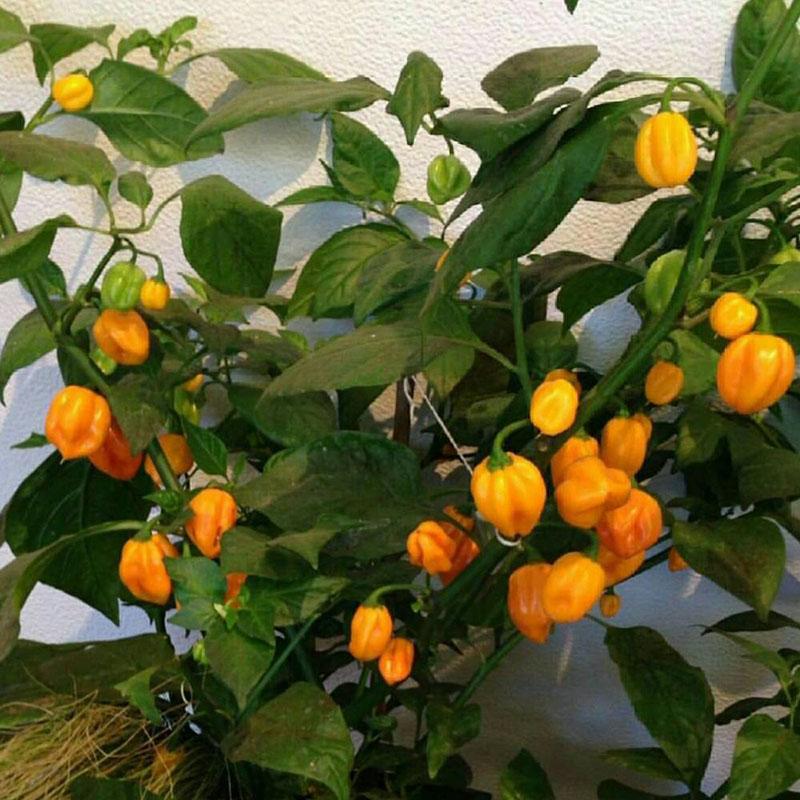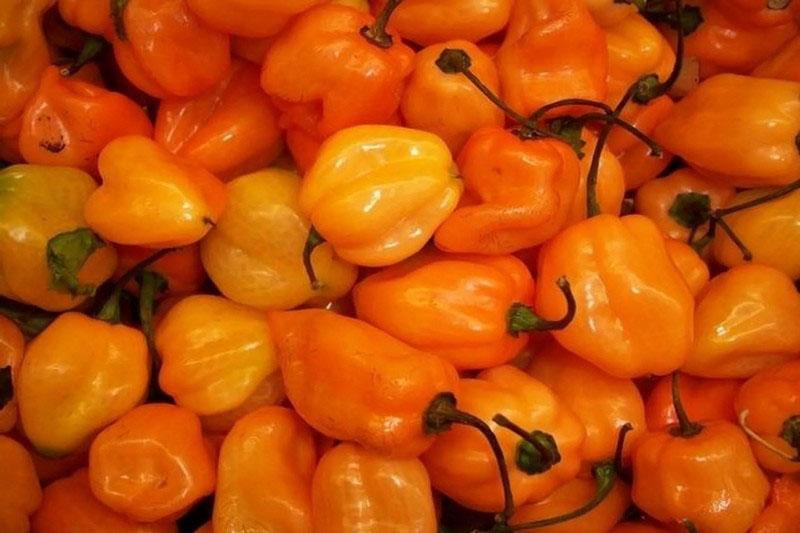How to grow Habanero hot peppers in summer cottages
 Habanero hot pepper, also known as Chinese Capsicum, is native to South America. It happened so because. that the Austrian scientist Nikolaus Jacquin, who described it, mistakenly assumed its origin. The fruits of this capsicum have such a pungent taste that it was recognized as the spicy of all in the culture. Its natural habitat includes Brazil, Mexico, Colombia and the Caribbean, but it is cultivated in many regions of the world with suitable climatic conditions.
Habanero hot pepper, also known as Chinese Capsicum, is native to South America. It happened so because. that the Austrian scientist Nikolaus Jacquin, who described it, mistakenly assumed its origin. The fruits of this capsicum have such a pungent taste that it was recognized as the spicy of all in the culture. Its natural habitat includes Brazil, Mexico, Colombia and the Caribbean, but it is cultivated in many regions of the world with suitable climatic conditions.
Description of hot Habanero pepper

The leaves of the pepper are elongated, rounded, dark green and shiny. Flowers are small, solitary. They can be white, pink or light purple. The fruits are different - cone-shaped, heart-shaped, or resemble a flashlight. If ribbing or wrinkling is observed, they appear cuboid. Their size is small, they do not exceed 6 cm in length, and their weight barely reaches 50 g.
Currently, there are many varieties of hot Habanero peppers that have bright red, yellow, white and orange fruits. There are also brown ones, very similar in color to chocolate.
 The fruits of this pepper only superficially resemble paprika. Their taste is so pungent that the peppers are never eaten fresh, but used in conservation or ground in dried form to prepare various spices. With proper care, a few Habanero bushes can yield a good harvest.
The fruits of this pepper only superficially resemble paprika. Their taste is so pungent that the peppers are never eaten fresh, but used in conservation or ground in dried form to prepare various spices. With proper care, a few Habanero bushes can yield a good harvest.
Growing habanero peppers
 In countries with tropical climates, Habanero is known as a perennial plant.
In countries with tropical climates, Habanero is known as a perennial plant.
But in the colder regions of the planet, it can only be cultivated as an annual:
- in greenhouses and temporary shelters;
- open ground;
- at home.
The heat-loving Habanero peppers require good lighting and a constant temperature of 24–26 ° C.
Soils for growing hot peppers should be light and fertile, moreover, slightly acidic. Plant care is not difficult for those gardeners who have already been involved in the cultivation of sweet or hot peppers. Suitable conditions favor year-round harvests.
But if Habanero is planned to be planted in open ground, you need to choose a site for this culture in such a way that:
- the sun illuminated him for the maximum amount of time;
- there were no drafts;
- tall and dense bushes grew along the edges, providing protection from strong winds.
If the Habanero grows at home, the plant pot is placed in a place where the sun is most illuminated. Most often, a south-facing window is chosen. Care must be taken to ensure that the plant does not suffer from drafts.
Hot peppers do not respond well to frequent watering. It is rarely watered, but water is not spared.
How to grow habanero peppers from seeds
 Seeds are sown in small and opaque containers, since light negatively affects the root system. Plastic cups wrapped in thick paper or foil will do. If you plan to plant many specimens in a greenhouse, the seedlings are grown in wooden boxes specially adapted for this purpose.At the bottom of which drainage needs to be poured - small pieces of foam, brick, expanded clay.
Seeds are sown in small and opaque containers, since light negatively affects the root system. Plastic cups wrapped in thick paper or foil will do. If you plan to plant many specimens in a greenhouse, the seedlings are grown in wooden boxes specially adapted for this purpose.At the bottom of which drainage needs to be poured - small pieces of foam, brick, expanded clay.
As a substrate, use a ready-made soil mixture purchased in a store or prepare it yourself. Peat is added to humus and a little vermiculite, perlite. And then the resulting soil is disinfected in any suitable way.
So that the grown seedlings, when transplanted to a permanent place, quickly adapt to new conditions, the basis of the soil for sowing seeds is taken directly from the beds.
Preparing seeds for planting

The germination of hot pepper seeds will not cause any problems if pre-sowing preparation is carried out in advance:
- about a month before sowing, they are warmed up;
- immediately before sowing, the seeds are treated with a fungicide, or soaked in a weak solution of potassium permanganate, and then washed with warm water;

- the seeds that have floated to the surface of the water, during soaking, are thrown away, since you will not have to wait for fruits from them;
- to speed up the germination of seeds, they are laid out on damp cotton pads and covered with small glass jars or cups, left for several days.

If the seeds are in a warm and humid place for two or three days, they will increase and germinate faster.
It is necessary to calculate the timing of sowing seeds in such a way that at least 9 weeks remain for the growth and development of seedlings. After which it will need to be transplanted to a permanent place. Usually seeds are sown in February.
Habanero hot peppers: sowing seeds
 The correct planting of seeds is of great importance for the development of peppers, and in the future the harvest.
The correct planting of seeds is of great importance for the development of peppers, and in the future the harvest.
It should be done according to certain rules:
- The soil is heated to +25 ° C. Pepper seeds are planted to a depth of no more than 1 cm.

- If sowing is done in boxes, a distance of at least 5 cm is left between the rows of seeds.

- After all the seeds are in place, they are sprinkled with soil and lightly tamped.
- The soil in the box is evenly watered with warm water, you can use a spray bottle.

- Cover with foil or transparent glass.

The first shoots will appear in 2–4 weeks. The rate at which the peppers begin to grow depends on the quality of the seeds and the correct soil composition.
Seedling Care Tips
As soon as the first shoots begin to appear, the film or glass can be removed. Now you should take care of full lighting of young plants, since their "day" should ideally last at least 16 hours. Will have to use lamps, the distance to which should not be less than 10 cm.
Despite the fact that it should be warm indoors when growing Habanero peppers, you should not forget about airing. After three true leaves appear on the plants, they can be transplanted into separate containers.
Actions for picking seedlings are performed in the following order:
- Potting soil is poured into pots with a diameter of at least 8 cm and watered.

- The boxes with seedlings are watered abundantly, after which the seedlings are taken out one by one, the central root is pinched and placed in the prepared pots.
- The sprouts, when planting, are buried to the cotyledon leaves, the soil near them is compacted.

After planting, the potted soil is watered again, and the surface is mulched with humus.
Outdoor Pepper Care
 So that the development of plants does not slow down after transplantation, they should be provided with adequate nutrition with the help of dressings, as well as timely watering. For Habanero pepper, watering is very important, but excess moisture, its stagnation, should not be allowed, because the plants can get sick from this. Watered once every three days. About 1 liter of water is poured under each bush. At the time of fruiting, the water rate is increased to 1.5 liters.
So that the development of plants does not slow down after transplantation, they should be provided with adequate nutrition with the help of dressings, as well as timely watering. For Habanero pepper, watering is very important, but excess moisture, its stagnation, should not be allowed, because the plants can get sick from this. Watered once every three days. About 1 liter of water is poured under each bush. At the time of fruiting, the water rate is increased to 1.5 liters.
 If pepper grows in an apartment or a private house, with the onset of the winter period, the plants are watered no more than once a week. With the arrival of spring, the volume of water for irrigation is increased, since the plant begins to actively grow leaves and stems. At this time, Habanero hot peppers need nitrogen.But fertilizers that contain this element cannot be used at the time of flowering or fruit setting. But phosphorus fertilizing can be carried out throughout the entire growing period, they improve plant growth and have a good effect on the root system.
If pepper grows in an apartment or a private house, with the onset of the winter period, the plants are watered no more than once a week. With the arrival of spring, the volume of water for irrigation is increased, since the plant begins to actively grow leaves and stems. At this time, Habanero hot peppers need nitrogen.But fertilizers that contain this element cannot be used at the time of flowering or fruit setting. But phosphorus fertilizing can be carried out throughout the entire growing period, they improve plant growth and have a good effect on the root system.
Plants respond positively to any organic feeding, with the exception of fresh manure.